Farm efficiency
JOEL MARTIN | Hagadone News Network | UPDATED 2 years, 10 months AGO
Joel Martin has been with the Columbia Basin Herald for more than 25 years in a variety of roles and is the most-tenured employee in the building. Martin is a married father of eight and enjoys spending time with his children and his wife, Christina. He is passionate about the paper’s mission of informing the people of the Columbia Basin because he knows it is important to record the history of the communities the publication serves. | January 26, 2023 1:30 AM
MOSES LAKE – As technology advances for fancy cars, trucks and devices in our pockets, so do advances in equipment used to grow our food. With employees stretched thin, advances in agricultural tech can help keep ag pros going.
“One of the biggest situations is labor,” said Tim Prickett, co-owner of Rashco Farm Supply in Moses Lake, Washington. “(The response to) the increases in cost of labor is to mechanize, improve their processes. So that's kind of what we try to do is to find equipment that is going to reduce their inputs and increase their outputs.”
Examples include tillage machines, laser-guided — Yes, you read that right, laser-guided – weeding machines and sensor-activated fertilizer machines that direct nutrients directly to planted seeds.
The Imants SX-series rotary spader helps with tillage work – the turning of soil to ensure nutrients such as manure and commercial fertilizers are buried underground. The Imants machine manages the tilling more efficiently with one pass rather than several.
“So you may have to go through and size material, like corn stalks or something, but other than that you go through with this one time and you can seed right behind it, as opposed to making multiple trips where they might go over with a with a disc, and then they might go with a with the disk ripper, and then they might come back with a seedbed maker or some kind of a seedbed preparation and then come back with the planter,” Prickett said.
The machine is expected to cut down time maintaining a field by a third to a half, Prickett said.
Imants said in a press release that the process mixes materials into the top layer of soil so that micro-organisms can break it down more easily.
“This way straw, corn stubble, green manure and compost can be evenly combined and provide the soil with the necessary nutrients,” the statement read.
Every gardner knows pulling weeds is a pain, but imagine weeding an entire field by hand. The HOAF KB Twin, made in the Netherlands, is a solution that saves on manpower – and on knee joints – by burning weeds with infrared technology and propane flames to burn weeds while leaving produce untouched.
“What it's designed to do is to kill the weeds and kill pathogens in the top eighth-inch, half-inch of soil depending on how hot you get it … it therefore allows for a cleaner field with less hand labor,” Prickett said.
An electronic ignition for the propane means the flame can be relit automatically. The flame also shuts off between rows to conserve fuel.
For something made a little closer to home, Carbon Robitics, a Seattle-based company, produces the Laserweeder. The machine is a self-driven device – think Roomba for an asparagus field – that uses a high-resolution camera to distinguish weeds from crops. It then burns the weeds with a laser.
The KB Twin and Laserweeder can be used in tandem for higher efficiency, Prickett said.
“This flamer will help speed the laser up,” he said, “because if the flamer can go through before the crops come up and take care of a substantial amount of weeds, then when the crop comes up, there's less weeds for the laser to have to deal with. So the laser should be more efficient and be able to cover more ground.”
Optical technology enables the Einböck Row-Guard cultivator as well.
“It has a camera and this camera can see multiple colors and multiple rows,” Prickett said. “So as you're driving to the field, it guides the cultivator within within a half an inch of the row. Even with the tractor being on GPS, the unevenness of a field, if you have that cultivator sitting on the back of the tractor rigid, and the tractor steers by the GPS, you're gonna damage some rows because of the normal drift of equipment on hillsides and that kind of thing. So this has been a great improvement.”
While the equipment isn’t inexpensive, Prickett said that it has the potential to save money by saving on manual labor in the field. Additionally, it keeps crops from competing with weeds for nutrients. It can also save hassle during harvest time.
“It's all about efficiencies,” Prickett said. “What we're seeing in the industry is, if (the customer) can see that the machine will decrease their costs or increase their outputs, even though they're expensive, they're looking at that product because of the labor issues. If one guy can do way more work in a day, they don't have to enter into all these problems with extra workers.”
Joel Martin may be reached at [email protected]. Read more of his work at www.basinbusinessjournal.com and www.columbiabasinherald.com.
ARTICLES BY JOEL MARTIN

‘Our favorite time of year’
Shop with a Cop brings smiles to both children and officers
MOSES LAKE — The heavy police presence outside local stores recently wasn’t because of a crime wave. It was police officers engaging in their favorite annual event. “This is one of those times throughout the year that we don't have to go and ask for volunteers to help,” said Moses Lake Police Chief David Sands. “The first day we put it out, I think we got 20-some people say ‘Yeah, we’re in.’ That's just under half the department right away.“

BASIN EVENTS: Dec. 19-27
COLUMBIA BASIN — It’s beginning to look a lot like Christmas, and a lot of people will be spending time at home with their families or at the church of their choice. Still, there are a few things happening around the Basin. Here are some ideas:

Chimney maintenance is essential for safety
MOSES LAKE — With Christmas just around the corner, lots of folks are using their fireplaces for warmth, roasting chestnuts or just a pleasant atmosphere. But before Santa pays your chimney a visit, you should make sure it’s in good working order. Chimney fires are responsible for more than three-fourths of residential building heating fires, according to the U.S. Fire Administration. Regular inspections and cleaning are the best way to prevent that, said Michael Harper, known as The Chimney Guy. “If they’re using (the fireplace) aesthetically – date night, Christmas, New Year’s, show-off times, something in the background here and there, (they should) have it inspected once a year for peace of mind,” Harper said. “If they’re using it two to three days a week religiously through the winter months, they need to have it cleaned once a year.”







